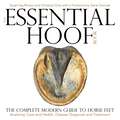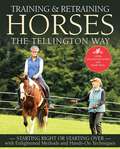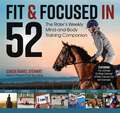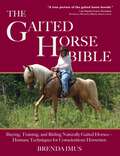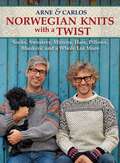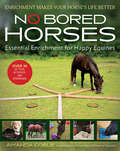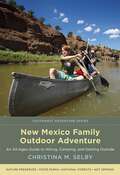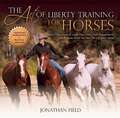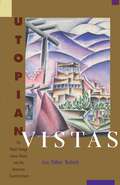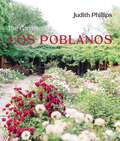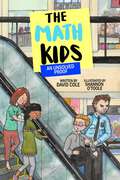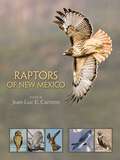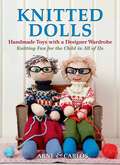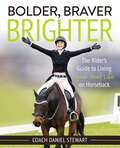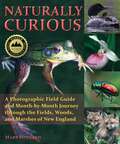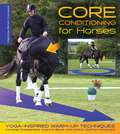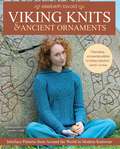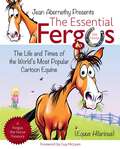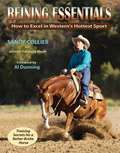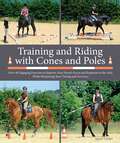- Table View
- List View
Essential Hoof Book
by Susan Kauffmann Cline ChristinaThe equine hoof is a complex marvel of natural engineering, built to withstand tremendous forces and able to adapt to an astonishing range of environmental conditions. It also changes daily–for better or for worse–in response to external and internal factors. Few horse owners have the opportunity to acquire a deep understanding of the hoof, which limits their ability to advocate on their horses&’ behalf and make informed decisions about hoof care and management. This book is the first resource of its kind to combine the most current and useful information available, gleaned from the research and wisdom of top hoof experts around the world, with a unique &“hands-on&” approach. The authors provide basic terms and anatomy, clearly illustrate the differences between healthy and unhealthy feet, discuss biomechanics and management concerns, and cover the causes, treatments, and prevention of commonly encountered problems, including laminitis, white line disease, and thrush. Along the way, readers are given activities to help them better analyze and understand the most important aspects of equine hoof health, such as hoof balance, depth of sole, and point of breakover. Easy–to–follow language, over 400 full–color photographs, and do–it–yourself exercises promise to empower horse owners and caretakers of all experience levels with the tools they need to accurately assess hoof health and keep their horses as sound and happy as possible.
Mesa Verde's Secret Garden: A History of Managing the Backcountry and Wilderness of a National Park
by Christopher BarnsMesa Verde National Park is the only congressionally designated land-based Wilderness to prohibit all recreational use. While backcountry use was encouraged for decades, stewardship changed over time as &“gardening&” the park for aesthetic purposes decreased while secrecy increased. The reasons for these changes, as Christopher Barns discovered, are multifaceted, but ultimately they reflect a desire to protect the park&’s thousands of archaeological sites, including six hundred Ancestral Puebloan cliff dwellings, while allowing natural processes to continue. However, much of the park is without recognizable cultural features, and if the public is prohibited from experiencing the surrounding landscape, Barns asks, what is being protected and for whom? Mesa Verde&’s Secret Garden is an authoritative history of Mesa Verde National Park&’s management. The book utilizes unpublished primary sources from the park&’s archives—including internal memos, public reports, interviews, and anonymous marginalia—and contextualizes them in the evolving (and often conflicting) federal and local priorities for Wilderness, conservation, and the national parks. The result of this painstaking research is a fascinating chronicle of national-park administration and development over a nearly 120-year history that provides unique insights into the people and protocols that have shaped the very landscape of Mesa Verde.
Horse by Nature
by Mary Ann SimondsThe first complete reference to help equestrians make the changes needed to ensure social license and the ability to ride and compete horses for years to come. Renowned wild horse ecologist and equine behaviorist Mary Ann Simonds provides a practical soup-to-nuts manual for understanding how horses think, feel, learn, communicate, and interact with each other and with humans. Integrating over 30 years of field research, identifying functional social behaviors in wild horses with her lifelong professional practice working with equestrians solving equine behavioral issues, Simonds helps readers gain a strong foundation into the emotional and cognitive lives of horses and explore various horse-human relationships. She provides numerous tools for assessing personalities, communicating with horses, and understanding how horses learn, with an emphasis on improving care and reducing stress in competitions and sports. In three parts, each introduced by top researchers and scientists in the equestrian field, readers will: LEARN the natural history and social ecology of free-roaming wild horses. UNDERSTAND the instincts, learned behaviors, gender differences, social roles, and social bonds that are the driving factors in horse culture. DISCOVER how adaptable horses really are, and how that makes them an ideal species to share their social lives with humans. FOCUS on horse-human relationships applying the knowledge from Part One to reduce equine stress and improve communication in the management and training of all horses. EXPLORE how to better assess the horse&’s personality and emotions, understand his learning style, and use various communication channels to establish trust, improve friendship, and enhance performance. ADDRESS the ethics of horse sports and ask the questions needed to ensure horse welfare in all the disciplines. CONSIDER dozens of changes related to horse management and competition recommended by respected industry professionals. BE EMPOWERED to be an influencer to improve the lives of horses, whatever the profession, breed, or sport. Filled with hundreds of color-coded tips and beautiful photos, and backed by science, personal stories, and unique insights, readers have multiple ways to quickly find useful information and apply it to their own horse-human situations. Whether preparing for a horse show, working with young stock, riding on the trails, adopting a wild horse, running a rescue, or just hoping to improve your communication and relationships with all horses, this book is a catalyst for much-needed change in the equine industry.
Gallop to Freedom
by Frederic Pignon Magali DelgadoWhenCavalia—the amazing equestrian-themed &“spectacular,&” melding costumes and theatrics with stunt riding and haute école—first took North America by storm in 2003, few people knew who Frédéric Pignon and Magali Delgado were. But the whole world was soon abuzz with talk of the magical display these two remarkable individuals provided their audience—whether horse-crazy or layperson, none could walk away unaffected by the powerful connection they demonstrated with their unparalleled cast of beautiful horses.Now in this remarkable book, Frédéric—a specialist in liberty and ground work—and Magali—a talented dressage rider at the Grand Prix level—combine efforts and share the secrets of the breathtaking relationships they have cultivated over the course of their lives with horses. They tell the story of Templado—the gorgeous but rebellious stallion who demanded they question all they had learned as horsemen and look at, in a whole new light, what it means to train horses. It was this tempestuous character that taught them that the process of building a relationship with a horse can be on more equal footing than most would dream possible.It is with this life-altering lesson in mind that Frédéric and Magali now explain their Six Golden Principles. These include how you can become a &“safe haven&”—the most important being in your horse&’s life—while ensuring he gets the leadership he craves and deserves. And, how to establish acceptable limits of behavior, as well as respect, without ever succumbing to anger or using force. They describe how to read horse behavior so you can better understand and communicate with your equine partner as an &“individual.&” Plus, you&’ll see what it means to be patient and &“give your horse a say&” in his own training—and just how rewarding the results can be.In a chapter devoted to their practical approach, you&’ll explore what is perhaps most central to their methods: the idea of &“play&” and how games can be used to develop a horse&’s intelligence, confidence, and desire to perform, whether at liberty or in the most difficult of competitive environments. Magali shares the example of her Grand Prix mount Dao, with whom she has reached the pinnacle of European competition, and whom dressage judges praise for his supple and stress-free performances.Both Frédéric and Magali once thought they had become skilled and compassionate riders and trainers, but found that the monumental challenges presented by Templado turned their beliefs upside down and made them start again from the beginning. They now view their work with horses as a journey of endless discovery and infinite rewards. With this book, full of phenomenal color photographs of their horses, many of whom appeared in the show that first made them famous, you can join—and learn from—them.
Training and Retraining Horses the Tellington Way
by Linda Tellington-JonesWorld-renowned equine expert Linda Tellington-Jones&’ healing equine bodywork and innovative training methods have revolutionized the horse training landscape over the last 50 years. Her unique blend of hands-on TTouch (a collection of circles, lifts, and slides done with the hands over various parts of the horse&’s body), combined with humane groundwork and under-saddle exercises, has helped solve training and behavioral problems for horses of every breed, every discipline, every age, and all levels. Now she is presenting a thoughtful recipe for starting the young horse without stress, helping to establish the very best beginning, in hand and under saddle. Unfortunately, not all horses have the benefit of the right foundation, which can lead to misunderstanding, mistreatment, and unhappiness for both human and horse. With this in mind, Tellington-Jones also curates her own experience working with older horses ready for a second chance at life, providing the necessary tools for filling in training &“holes&” and reconfirming lessons that may have been poorly taught or forgotten. The result is book with all the right ingredients and its heart in the right place: Whether starting right or starting over, Tellington-Jones&’s field-tested, compassionate answers are an excellent way to find connection while ensuring the horse a lifetime of success in the company of humans.
Fit & Focused in 52
by Daniel StewartCoach Daniel Stewart has made a name for himself over the past 25 years, enthusiastically training riders of all levels throughout the world, as well as coaching top athletes on several US Equestrian Teams at World Championships, World Equestrian Games, and the Olympics. He's widely considered one of the world's leading experts on equestrian sport psychology, athletics, and performance, providing tips and quips at hundreds of clinics a year, in his bestselling books, and online through his Pressure Proof Academy.Now Coach Stewart is combining his popular rider mental conditioning techniques with ideas for physical conditioning, as well. InFit & Focused in 52, readers get quick-hit recommendations for one exercise for the body, and one for the mind, for every week of the year. The end goal is attaining full-on fitness that ensures improved performance on horseback, whatever your age, ability, or discipline. With 52 weeks of creative cross-training, and loads of ideas for customizing workouts to fit personal goals and lifestyle schedules, riders are sure to find themselves positive, pumped up, and ready to go, from head to toe.
Gaited Horse Bible
by Brenda ImusThe gaited horse—bred and trained to perform smooth-to-ride, ground-covering alternative gaits (not the trot/jog or canter/lope) that can often be sustained long distances and sometimes at astounding speeds—has steadily gained mainstream popularity as a pleasure or trail mount, in addition to its traditional status as a top-notch show-ring competitor. While generations of careful breeding have instilled a natural ability to gait in certain breeds, the smooth saddle gaits are not necessarily automatic. This means that riders, whether exploring the backcountry or vying for a championship ribbon, need to train their gaited horse to be able to perform, and then school him to perform well, consistently, and without doing damage to his body. The best person to develop your gaited horse's smooth saddle gaits is you! writes renowned gaited-horse trainer and clinician Brenda Imus in The Gaited Horse Bible. You need to learn only a few basic principles to develop and maintain your horse's gaits. As you do, you will build an important relationship with him (as well as saving trainer's fees). It's a 'win-win' situation all the way around. From the simplest, clearest explanation of the Gait Spectrum you'll find, to a discussion of gaited horse breeds (their history, characteristics, and uses) and gaits (running walk, rack, fox trot, tolt, trocha, for example), to an in-depth study of conformation, movement, and soundness—it's all in this terrific resources. Year-by-year basic training and advanced schooling, including flexion, collection, and lateral work to improve natural gaiting ability, is followed by a superb problem-solving section that features simple exercises for alleviating common behavioral problems, avoiding and correcting physical issues, and fixing deviations in a horse's smooth gaits. With a summary of bridles, bits, saddle fit and back dynamics, as well as optimal shoeing and trimming for gaited horses, The Gaited Horse Bible is the perfect how-to package for every gaited horse rider and owner.
Riding for the Team
by Nancy Jaffer&“To win for the USA.&” Many young athletes grow up with a goal of reaching the Olympics and the glories of their sport&’s highest levels. It is no different for equestrians, whether they ride English, Western, vault, or drive a carriage. From playing with plastic ponies and taking their first riding lessons, to finding success in the arena, thousands of horse lovers hope they can one day represent the United States in international competition.Riding for the Teamchronicles the lives of those who dreamed about competing for their country and &“made it,&” sharing inspirational stories from the international governing organization&’s eight equestrian disciplines: show jumping, dressage, eventing, driving, vaulting, reining, endurance, and para-dressage.Readers are immersed in the fascinating histories of the medal-winning riders, drivers, and vaulters who have dominated American equestrian sport over the past 28 years, such as McLain Ward, Karen O&’Connor, Debbie McDonald, and Tim McQuay. Get the inside scoop on legendary horses who have become household names, including Flexible, Biko, Verdades, and Gunners Special Nite. Offering exclusive insights, this book gives readers a behind-the-scenes look at the world of top-level equestrian sport. Athletes tell their stories and those of their horses during the years they honed their talent and dedicated their lives to representing their country in the Olympics, World Equestrian Games, World Championships, and Pan American Games. Beautifully illustrated with breathtaking photographs from prestigious competitions held around the world,Riding for the Teamnot only provides a dazzling record of American equestrian accomplishment, it promises to inspire the next generation of champions.
Norwegian Knits with a Twist
by Carlos Zachrison Arne NerjordetTraditional embroidery, tapestry, and knitting motifs from Setesdal, in the south of Norway, are brilliantly reconceived in this fabulously fresh collection of knitting projects from Arne and Carlos. Through experience gained from working alongside Scandinavia&’s most respected knitters, Arne and Carlos seek to preserve tradition—with their own creative &“twist&”! Over 30 patterns promise endless sources of delight and inspiration: men&’s and women&’s sweaters, pillows, hats, cowls, mittens, wrist and leg warmers, socks, blankets, and so much more! Includes gorgeous photographs, step-by-step instructions, and pattern diagrams.
No Bored Horses
by Amanda GobleA groundbreaking book by an animal enrichment specialist, the first on the subject showing exactly what's missing from the modern horse's life:enrichment and boredom-relief.Today horses are thought of as family members, athletic partners, and patient teachers and therapists. Most of us do our very best to give them all the benefits that contemporary domestic life can offer: comfortable stalls; carefully prepared and regular meals with vitamins and supplements; top-notch veterinary and hoof care; even regular bodywork.So why do so many horses struggle with health, behavioral, and training problems?In her groundbreaking book, the first on the subject written specifically with horses in mind, animal enrichment specialist and zookeeper Amanda Goble shows readers exactly what's missing from the modern horse's life:enrichment and boredom-relief. By giving equines back the crucial natural behaviors, stimulation, and enriching experiences they crave, we can truly change their lives—and ours as their riders, trainers, and caregivers—for the better.Far more than a simple list of toys you can buy,No Bored Horsesexplains why unique equine behaviors matter to horses, and how today's style of equine care can actually make it impossible for horses to behave like horses, resulting in vices and behaviors that are in essence a cry for help. Goble believes that equestrians can benefit from what zookeepers like her already know: enrichment is more than just fun and games for animals-it is essential for their mental and physical health. The companion animal world has already embraced forms of enrichment as a powerful tool for reducing behavior problems and improving pet-owner relationships. But the equestrian world has lagged behind, without resources or information on how to give their horses the same level of love and care.Until now.Leveraging her passion for horses and animal behavior with a zoo professional's knowledge of enrichment techniques, and coupling them with a strong background in education and the creative space, Goble breaks complicated topics into accessible, punchy bites of content that make sense. And as a lifelong horse owner, she can help us overcome challenges from the ground up—because she's been (and maybe still is) in our shoes.Chock full of fantastically engaging original illustrations, diagrams, and charts, plus color photographs and instructions for more than 30 toys, puzzles, and experiences attainable forallequestrians, regardless of level of experience or size of budget, Goble's book promises every horseperson can afford to make her recommended changes and ultimately improve a horse's life. Plus, alongside plenty of inspiration for everyday fun, readers will also find valuable advice for the most challenging situations, like extended stall rest and quarantine.No Bored Horsesis for every desperate equestrian whose horse is going stir-crazy, and for the owner of the horse with behavioral problems that she just can't seem to fix. And it is for every one of us whose aim is to give our horses the experiences and opportunities that create true well-being in our company.
Horse Color Explored
by Vera KurskayaEveryone stops and stares at a horse with beautiful or unusual color. So striking are the variations of bay, gray, chestnut, black, solid, and spotted that many people breed for specific combinations. This has led to a marked increase in international interest in the study of horse color genetics— well as a need for an easy-- reference suitable for the layperson who also wants to understand the science behind it all.In these pages, horsewoman and genetics specialist Vera Kurskaya provides a guide that aims to not only provide basic information about horse color appropriate for a general audience, but also explore the specifics of inheritance and recent color genetics research certain to inform serious aficionados worldwide. With 160+ color photographs in handy reference sections throughout, as well as a look at special hair features, the evolution of horse color, and the effect of color on performance, fertility, and character,Horse Color Exploredis a fascinating and valuable resource for the modern horseperson.a Manchado horsea Rabicano horse
New Mexico Family Outdoor Adventure: An All-Ages Guide to Hiking, Camping, and Getting Outside (Southwest Adventure Series)
by Christina M. SelbyAn experienced outdoors writer, naturalist, and family camper, Christina M. Selby offers families an in-depth guide to experiencing the natural splendors of New Mexico in New Mexico Family Outdoor Adventure. With more than eighty destinations throughout the state, the Land of Enchantment offers abundant opportunities for exploration with hiking, biking, camping, skiing, wildlife watching, fishing, climbing, outdoor cultural activities, and more. Parents, grandparents, children, tweens, and teenagers will enjoy the activities and locations that Selby has enjoyed with her family and features throughout the book.Organized geographically, with easy-to-use maps, the guide explores every corner of the state with detailed descriptions and beautiful photography of trails, campsites, rivers, and lakes. At each location, every outdoor activity is graded in terms of difficulty and age-appropriateness, so you&’ll know exactly the right activities for every member of your family. Whether you&’re planning your first family adventure or are an experienced outdoors family, pick a destination and get outside. What are you waiting for?
Art of Liberty Training for Horses
by Jonathan FieldHorse trainer Jonathan Field has made a name for himself with his unique ability to give people simple, understandable, doable steps that lead to working with a horse &“at liberty&” in a safe and progressive manner. True engagement with a horse at liberty isn&’t just about removing tack and stepping outside the arena—it&’s about connection, trust, and communication through movement. Enrich your relationship with your horse, improve your &“feel,&” and teach your horse to respond to the subtlest of cues; no matter your discipline, whether you compete or ride for pleasure, liberty training can change the way you interact with horses forever.
Utopian Vistas: The Mabel Dodge Luhan House and the American Counterculture
by Lois Palken RudnickWinner of the 1996 Gaspar Perez de Villegra Award from the Historical Society of New MexicoMabel Dodge Luhan, hostess and visionary, made Taos, New Mexico, a center for artists and utopians when she moved there in 1917 and began inviting friends to visit her. Now available in paperback, Utopian Vistas is a chronicle of the house Luhan built in Taos and the poets, painters, photographers, film-makers, writers, educators, and visionaries whose lives and works were affected by the house and its environs. Lois Rudnick weaves a complex tapestry depicting American countercultures in New Mexico from the 1920s to the 1990s.Should be required reading for art historians,film historians, ex-Beats and hippies, their children and grandchildren, and anyone interested in the possibility of making an imperfect America perfect at last.--Karal Ann Marling
The Gardens of Los Poblanos (New Century Gardens and Landscapes of the American Southwest)
by Judith PhillipsIn The Gardens of Los Poblanos, landscape designer and garden writer Judith Phillips recounts the history of these world-renowned gardens and demonstrates the ways in which the farm&’s owners, designers, and gardeners have influenced the evolution of this unique landscape. Phillips showcases how the changes in landscape style and content are driven by cultural expectations and climatic realities, and she discusses how the gardens of Los Poblanos have helped preserve the deep agrarian roots of the village of Los Ranchos de Albuquerque. Although plants are always a focus for Phillips, she demonstrates how gardens are more than plants and how plants are much more than mere fillers of garden space.
An Unsolved Proof: The Math Kids (Book 9) (The Math Kids)
by David ColeHidden cameras, secret operations, and new math concepts await in the Math Kids' ninth adventure!Justin has been accused of stealing from the comic book shop! To earn back the trust of his parents and the store manager, he'll have to work at the shop for four whole weekends. And that puts a damper on his plans to play video games and hang out with fellow Math Kids, Jordan, Catherine, and Stephanie. With the end of summer approaching, the four friends realize that finding proof of Justin's innocence is their only way to save Justin's good name. To get it, they'll need to uncover who really stole the comics. Their primary suspects are the two older boys who accused Justin, but catching them red-handed will require more than just teamwork. Solving this problem will require knowledge of proofs and patterns, and if the Math Kids aren't successful, it won't be just Justin's reputation at risk.
Raptors of New Mexico
by Jean-Luc E. CartronNo book has ever before specifically focused on the birds of prey of New Mexico. Both Florence Bailey (1928) and J. Stokley Ligon (1961) published volumes on the birds of New Mexico, but their coverage of raptors was somewhat limited. In the ensuing years a great deal of new information has been collected on these mighty hunters' distribution, ecology, and conservation, including in New Mexico.The book begins with a history of the word "raptor." The order of Raptatores, or Raptores, was first used to classify birds of prey in the early nineteenth century, derived from the Latin word raptor, one who seizes by force. The text then includes the writings of thirty-seven contributing authors who relate their observations on these regal species.For example, Joe Truett recounts the following in the chapter on the Swainson's Hawk:"From spring to fall each year at the Jornada Caves in the Jornada del Muerto, Swainson's hawks assemble daily to catch bats. The bats exit the caves--actually lava tubes--near sundown. The hawks swoop in, snatch bats from the air, and eat them on the wing."Originally from France, Jean-Luc Cartron has lived and worked on several continents, finding his passion in the wide-open spaces of New Mexico. He became fascinated by the birds of prey and has studied their ecology and conservation for nearly twenty years.Raptors of New Mexico will provide readers with a comprehensive treatment of all hawks, eagles, kites, vultures, falcons, and owls breeding or wintering in New Mexico, or simply migrating through the state. This landmark study is also beautifully illustrated with more than six hundred photographs, including the work of more than one hundred photographers, and more than twenty species distribution maps.
Knitted Dolls
by Carlos Zachrison Arne NerjordetScandinavian knitting sensations Arne and Carlos (authors of55 Christmas Balls to Knit) admit that they both have an inner child who, in their case, is more present than not! They find great inspiration in quirkiness and whimsy, and their trademark style and sense of humor is in a large part fresh and unique because of their ability to see the world through a child's eyes. Arne and Carlos now aspire to bring a little of the fun to you, with this, a fantastic collection of knitted dolls, as well as instructions for building a charming knitted wardrobe around them. Based on the dolls Arne and Carlos used during their career in the fashion design industry (they would design clothing in miniature before transforming them into human sizes), you'll find easy-to-knit instructions for five doll bodies and tips for giving them features. Then, you get to dress them up! From underwear to overcoats, you'll find miniature knits to suit all seasons. With themes supplied to organize the patterns and ignite your imagination—To the Mountains, Coffee Break, Ship Ahoy!—you're destined to find yourself transported into another (albeit smaller) world.Whether knitting dolls for your own enjoyment, or to collect and give to a child or grandchild, the playful universe created by Arne and Carlos is one you'll enjoy exploring. Designs are appropriate for knitters of every ability level, although advanced knitters can also resize the patterns to knit favorite garments for humans—just like Arne and Carlos did in their designer days.Click here to download a Pattern Correction for page 29.Click here to download instructions for adding dolls hair.
Bolder Braver Brighter
by Daniel StewartExciting ideas for achieving riding and training goals from the master of mental training for the equestrian athlete.Coach Daniel Stewart, author of the hit mind-and-body equestrian workoutFit and Focused in 52, is back with new plans to power you up, bolster your confidence, and supply you with the mental tools you need to be all you can be, in and out of the saddle. With Coach Stewart's infectious optimism and indomitable sense of fun, readers will find themselves embracing exhilarating changes in their outlook and their abilities. The evolution from &“good enough&” to &“better&” begins with:Understanding the attributes that create success.Comprehending the four stages of competence.Improving mindfulness of actions and reactions.Identifying good stress and bad stress
Naturally Curious
by Mary HollandAre you ready for a glimpse into the dark, subterranean world of the star-nosed mole? A barred owl's late-winter call to take on new meaning? The life cycle of the eastern newt to suddenly seem complex, beautiful, and intricately bound to mysterious underwater landscapes and damp forest floors? Naturalist and environmental educator Mary Holland's visually astounding book Naturally Curious promises a walk in the woods (or a field or wetland) will never be the same. With boundless enthusiasm and a lifetime's-worth of natural history knowledge, Holland escorts you through the New England seasons, month by month—in sun, rain, and snow; along roadsides and riverbanks; above burrows and under treetop nesting sites. Beginning with March and its early stirrings of life awakening after a long cold winter, and ending in February as survival becomes the sole focus of all plants and creatures, great and small, Holland provides hundreds of fascinating Nature Notes. These bite-size nuggets of fact-based information detail a species' actions in a particular month—whether courting, breeding, singing, burrowing, migrating, or caching food, for example. In addition, you'll find pertinent lists of the amphibians, reptiles, birds, mammals, insects and arachnids, and plants and fungi you might expect to see or hear from as the weeks go by. But that's not all: Each month culminates in specially chosen essays, where Holland gets up-close-and-personal with New England plant and animal life and some of their more intriguing typicalities and peculiarities, illustrating their impact on the region and those who share it. Throughout, the many exciting and varied worlds of the Northeast explode upon the page in an unmatched visual display of full-color photographs. From the minutiae (the migration of the tiny snow flea on a warm winter's day) to the massive (the wallowing practices of the bull moose in rut) this is the region and its inhabitants like you've never seen them before. By deftly melding the practical field guide we all need with the kind of book we all want to sit back and read, Holland does New England—and those who live in it, visit it, and love it—an immense service. Adults and children alike are sure to be fascinated by the natural world in this book, in their backyard, and even further afield. Naturally Curious is truly an into this world experience.
Core Conditioning for Horses
by Simon CocozzaEvery equestrian wants to know: what is the difference between the horse that &“dances&” when you are on him, and the one that doesn&’t? According to Visconte Simon Cocozza, Trainer and Examiner for the La Fédération Française d'Equitation (FFE), it all comes down to the horse&’s posture. The horse&’s ability to use the powerful mechanisms already built into his body reliesnotupon the strength we can see on the outside but the strength on theinside. This invisible and complex arrangement of internal &“core&” muscles control the horse&’s posture, suppleness, and agility. Their good condition is the key to the dance.Equine core muscles are very difficult to isolate with the traditional training techniques common to horse sports. However, by examining what we do with thehumanbody when faced with a weak core, we can find new methods for conditioning these areas of the equine body. Visconte Cocozza has taken principles of the human practice of yoga and used them to develop novel ways of reaching deep within the horse&’s body and gently &“unlock&” areas that may be a little &“rusty,&” improve core fitness, and even relieve pain related to conditions such as kissing spine. In this book, he provides step-by-step instruction explaining easy mounted exercises that enhance the horse&’s posture, and boost his confidence in his body and movement, making him easier to ride, and ultimately, the dance partner you&’ve always imagined.
Viking Knits and Ancient Ornaments
by Elsebeth LavoldEver since her ground-breaking bookViking Patterns for Knittingwas published, Elsebeth Lavold has been recognized as one of the world's leading experts on cabling. In the book, described as an indispensable milestone in 20th century knitting literature, she introduces her own innovation, using lifted increases to create interlace patterns instead of just to shape garments, and to bring new life to the ornamental heritage of the Vikings as adornment on modern knitwear.With more than a decade of added experience and continued research, she took the concept a step further. Still firmly based in her Scandinavian roots, she has studied cultures from all over the globe to find similar types of patterns. This resulted in a fascinating compilation of ornamental expressions, ancient as well as contemporary, and just as inViking Patterns for Knittingshe uses them as a launch pad for her own unique designs.Elsebeth genuinely enjoys sharing her knowledge. In addition to the abundance of beautiful garments presented in the book with complete instructions, she has analyzed a huge number of pattern types and displays them in both swatch and chart form, to allow you to make your own designs based on her research.Pattern corrections
Essential Fergus the Horse
by Jean AbernethyIn the late 1990s, a little bay horse with white socks and a blaze was born. Dubbed &“Fergus,&” he has now traveled the world many times over by print, web, and satellite, inspired a line of merchandise, and gained a devoted following in the hundreds-of-thousands on Facebook and other social media. Who is this horse and how can we explain his magnetism? What makes him so special? Fergus the Horse (Equus hilarious) is the creation of Jean Abernethy, and the truth is, he isn&’t meant to represent any one breed or discipline. Perhaps it&’s this generic &“everyhorse&” quality that&’s led to his popularity. &“When fans write, &‘Fergus reminds me of my horse,&’ I cannot be paid a higher compliment,&” says Abernethy. And it&’s his expressiveness, honesty, charm, and keen sense of humor that truly wins our hearts. Now Abernethy has brought together the backstory of Fergus the Horse—how he came to be, his early years, the history of his &“friends&”—and combined it with his &“greatest hits,&” including most-loved comic strips, some personal sketches, and brand new additions. The result is a lively, colorful, highly illustrated treasury that will entertain anyone with an eye for a horse and a need for a laugh.
Reining Essentials
by Sandy CollierWorld Champion trainer and rider Sandy Collier provides this indispensable guide of progressive training exercises for the reining horse. Whether green broke, or &“push-button,&” every horse will perform more willingly, cleanly, and quickly with work on what she calls the &“Seven Essentials&”—the foundational basics every riding horse needs. Like no other book out there, Collier breaks down the maneuvers required in a reining pattern and the tricks and techniques for introducing them, perfecting them, and showing them off in competition.You&’ll learn about:• Collection and steering—condensing your horse&’s frame and getting his feet to follow his nose• Lead departures, circles, and spins—preparing for the lope, &“hunting the circle,&” and driving into the spin• Stops, back-ups, and rollbacks—perfecting the slide, moving backward with cadence, and swinging &‘round 180 degrees over the hocks• Lead changes—getting it right and preventing anticipation
Training and Riding with Cones and Poles
by Sigrid Sch??peTraining your horse to concentrate on a lesson, bend his body from nose to tail, and pay attention to where he places his feet—whatever your discipline or level of expertise, these are necessary foundation skills.Here you will find an incredibly handy guide to introducing and solidifying these concepts, as well as many others, with exercises using two very basic training tools: traffic cones and ground poles. Arranged in an easy-to-view format so you can work through the exercises progressively, or dip in and try ideas à la carte, these pages provide all you need to reinvigorate arena workouts and keep both you and your horse engaged in the training process.In addition, you'll discover that incorporating cones and poles in your daily lessons not only provides visual interest and physical guidelines for your horse as he moves around the ring, it also gives you a means of developing accuracy in your schooling figures and transitions. With these exercises, your horse's movement and response to your aids will certainly improve, but so will your overall riding performance.
